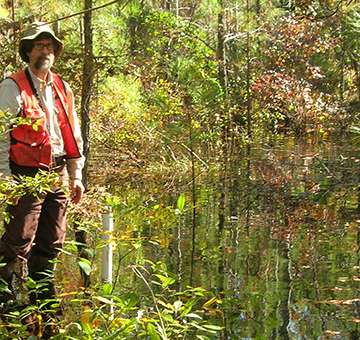Finding the connections to "isolated" wetlands

Most people don't give much thought to water quality – until they find their water lacking. And enjoying the benefits of good beaches, fishing, swimming, canoeing and drinking water is not something that can be done in isolation. Clean water is the result of one of the most interconnected networks on the earth: the water cycle.
Dan Tufford, an ecologist in USC's College of Arts and Sciences, sees the connectedness more clearly than most. As part of a research team that spent six years studying what are termed "geographically isolated wetlands" in the Carolina coastal plain, he contributed to two EPA reports revealing the often-overlooked ways they connect with remote water sources. His testimony before a committee in the South Carolina state legislature was part of a now-decade-long effort to establish rules for these wetlands, which have not been under federal jurisdiction since 2001.
Isolated wetlands fill with water in the rainy season and, if small enough, go dry in the summer months. They're typically small, with a median size just under a half an acre. Any wetland with no apparent surface connection to nearby waters is classified as an isolated wetland, and for many years, the isolation was thought to be complete. But evidence of subsurface and transient surface connections led to the more precise term "geographically isolated wetlands" in 2002.
Tufford and the team of researchers from the University of South Carolina, the North Carolina Department of Environment and Natural Resources, the Research Triangle Institute and the North Carolina Center for Geographic Information and Analysis rigorously demonstrated that a huge number of these so-called isolated wetlands are not really isolated. Starting in 2007, the team undertook field studies in eight counties, four from each state. They developed a census for the counties and studied a number of isolated wetlands in great hydrological detail.
"Some of them have streams coming out of them, some of them have streams going into them," Tufford said. "Many of them have been ditched for agricultural purposes."
The team found underground connections as well. "What we found out is that there is actually a substantial shallow groundwater connection between 'isolated' wetlands and other water bodies," Tufford said. "We measured a shallow groundwater connection across several hundred yards in one case, so it is not like they have to be just within a few yards of a stream. They can be actually quite distant."
The so-called "isolated" wetlands thus contribute to water quality in a much larger context, and this is particularly important given recent legal activity. Improvements to private property are often largely unregulated outside of densely inhabited areas, but when wetlands are present, the situation is different. Physical changes on land containing wetlands can potentially affect water quality much further away, so they have both federal and state-level protections. But not so for "isolated wetlands."
"As a result of a Supreme Court decision in 2001, isolated wetlands are no longer regulated under federal authority," Tufford said. "Because they are no longer being regulated under any federal programs, there is a concern that they are being destroyed, and that there will be negative impacts to water quantity, water quality, and plants and animals."
"North Carolina right away passed regulations that, although nobody calls them perfect, are certainly better than not having anything at all. South Carolina has been struggling with that."
The South Carolina legislature has tried several times since 2001 to develop a regulatory framework to replace the lost federal oversight, but with no success. "One of the outcomes of the legislative activity last year is that they decided not to do anything relative to isolated wetlands, but they mandated that an isolated wetlands task force would meet and make recommendations about what to do this year," Tufford said. "My testimony for this committee was to summarize the results of this research."
The 2013 legislative session has, however, come and gone without any further action.
"When we think about wetlands here, we think of huge bottomland hardwood swamps, like Congaree National Park. We think about salt marshes on our coasts," said Tufford. "That is one of the difficulties with getting good regulations passed for isolated wetlands, because it's really hard to help people develop a personal connection to them and why they might be important."
"But that doesn't diminish their importance. There are a lot of them out there. They have important habitat value for plants and animals. And we showed that there is a potentially significant impact of isolated wetlands on the amount of water that is in nearby streams – and not just the amount of water, but the quality of the water there."
Provided by University of South Carolina


















